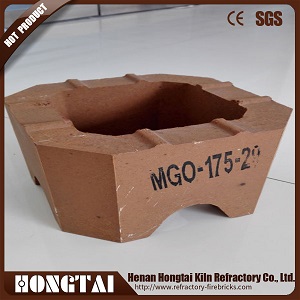Influence of chromite composition on properties of magnesia-chrome bricks
Apr 01, 2022
Chromite is the main raw material for the production of magnesia-chrome bricks, magnesia bricks, and chrome-magnesium bricks, and the composition of its mineral components is also one of the important factors affecting the performance of magnesia-chrome bricks.
The influence of SiO2 content on the high-temperature properties of magnesia-chromium refractories is very significant. The magnesia-chrome brick with low SiO2 content has a significantly higher degree of direct bonding (see Figure 1), and the softening point under high-temperature load is also higher than that of the magnesia-chrome brick with higher SiO2 content (see Table 1). This is because SiO2 and Fe2O3 in chromite from fayalite (Fe2SiO4), which has a very low melting point; the content of SiO2 is low, and the silicate phase formed at the firing temperature is less, and the silicate layer in the brick structure is high. Instead of direct bonding between refractory phase crystals.
High SiO2 content is also detrimental to the erosion resistance of refractories, even high-grade chromite with high Cr2O3 content. In the study of SiO in high-grade chromite ore with fused magnesia, it was found that SiO and MgO generate a silicate liquid phase, SiO content is high, and the liquid phase generation amount is also high, as slag erodes fused MgO, The liquid phase has been intruded into the inside of the fused MgO.

In order to improve the degree of direct bonding of magnesia-chrome bricks, they are often fired at higher temperatures, but the waste caused by firing deformation also increases. It is very practical to take measures to reduce the content of SiO2 in the ingredients (especially the content of SiO2 in chromite) in terms of process technology to improve the yield.
In order to obtain magnesia-chrome bricks with a high direct bonding rate, the content of CaO in the raw material should also be reduced, because it is also the main source of increasing the content of the silicate phase in magnesia-chrome bricks. Fortunately, the CaO content in most chromites is not very high.
Even if the content of SiO2 and CaO in chromite is the same, the influence of different types of chromite (ie, the ratio of Al2O3/Cr2O3 and Fe2O3/Cr2O3 is different) on the properties of magnesia-chrome bricks is very obvious. The research on the influence of Cr2O3, Al2O3, and Fe2O3 in magnesia-chrome bricks on the dihedral angle between adjacent periclase grains shows that the combination of periclase and periclase will be strengthened by Cr2O3 and weakened by Fe2O3 and Al2O3; Both Fe2O3 and Al2O3 increase the melting point of the silicate phase. Using chromite with high Cr2O3 content (with the corresponding reduction in Al2O3 and iron) can achieve higher high-temperature strength than chromite with low Cr2O3. However, chromite with high Cr2O3 content is more expensive, and a compromise solution can be adopted in actual production according to the requirements for brick performance.
Relevant information
-

Main properties of magnesium oxide refractory
Performance characteristics of magnesia refractories and other basic refractories Performance characteristics of magnesia refractories and other basic refractories Refractories containing more than 80% ... -

What properties of lightweight insulation fire clay bricks can be improved by the addition of kyanite?
Lightweight insulation fire clay bricks are a kind of shaped refractory material with clay as the main raw material, which is processed, shaped, dried, and calcined with clay. on the kiln. Due to the r ... -

How is the effect of white fused alumina abrasive used in refractory materials?
After mixing, forming, drying, and firing at high temperature in a shuttle kiln. The product has the characteristics of high refractoriness, good thermal shock stability of white corundum, high high te ... -

Characteristics of refractory magnesia chrome bricks for lime kiln
Lime kilns are mainly classified into square kilns and circular kilns. According to the classification of fired products, they can be divided into lime kilns, ceramic kilns, cement kilns, glass kilns, ...

